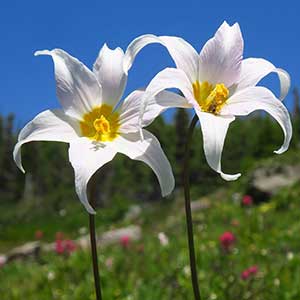Erythronium propullans
Erythronium montanum
Minnesota dwarf trout-lily, Minnesota fawnlily, Minnesota trout lily
avalanche-lily, white avalanche-lily, white glacier lily
ovoid, 10–25 mm;
stolon 1 in flowering plants, arising from halfway up stem, 1–3 from bulbs of 1-leaved, nonflowering plants.
narrowly ovoid, 25–60 mm.
4–13 cm;
blade green, irregularly mottled, elliptic-lanceolate to ovate-lanceolate or elliptic, ± flat, glaucous, margins entire.
10–20 cm;
blade green, ovate to broadly lanceolate, base ± abruptly narrowed to petiole, margins wavy.
3.9–12 cm.
12–35 cm.
1-flowered.
1–3-flowered.
tepals 4–6, strongly reflexed at anthesis, pale pink to white, darker abaxially, lanceolate, 8–15 mm, auricles absent;
stamens 2–6, 6–8 mm;
filaments white, lanceolate;
anthers yellow;
pollen yellow;
style white, 6–10 mm;
stigma ± unlobed.
tepals white to creamy white with bright yellow zone at base, broadly ovate to broadly lanceolate, 25–45 mm, inner wider than outer, auriculate at base, length less than 4 times width;
stamens 12–24 mm;
filaments white, linear, slender, less than 0.8 mm wide;
anthers bright yellow;
style white, 13–25 mm;
stigma with slender, usually recurved lobes 1–5 mm.
very rarely produced; when present, may be result of hybridization with Erythronium albidum.
oblong, 3–6 cm.
= 24.
Erythronium propullans
Erythronium montanum
Of conservation concern.
Erythronium propullans is known only from Goodhue and Rice counties. It often forms extensive colonies in which flowering plants are sometimes more abundant than nonflowering, 1-leaved ones, and sometimes the reverse. It grows mixed with E. albidum (J. A. Banks 1980), and putative hybrids between them have been reported (T. Morley 1988). Flowers frequently have fewer than six tepals and stamens (C. O. Rosendahl 1919), and may occasionally have only two carpels.
(Discussion copyrighted by Flora of North America; reprinted with permission.)
This species occurs in the Coast Ranges of southern British Columbia, and disjunctly to southern Vancouver Island, the Olympic Peninsula, and Cascade Mountains from Mount Rainier National Park in Washington to central Oregon.
(Discussion copyrighted by Flora of North America; reprinted with permission.)


